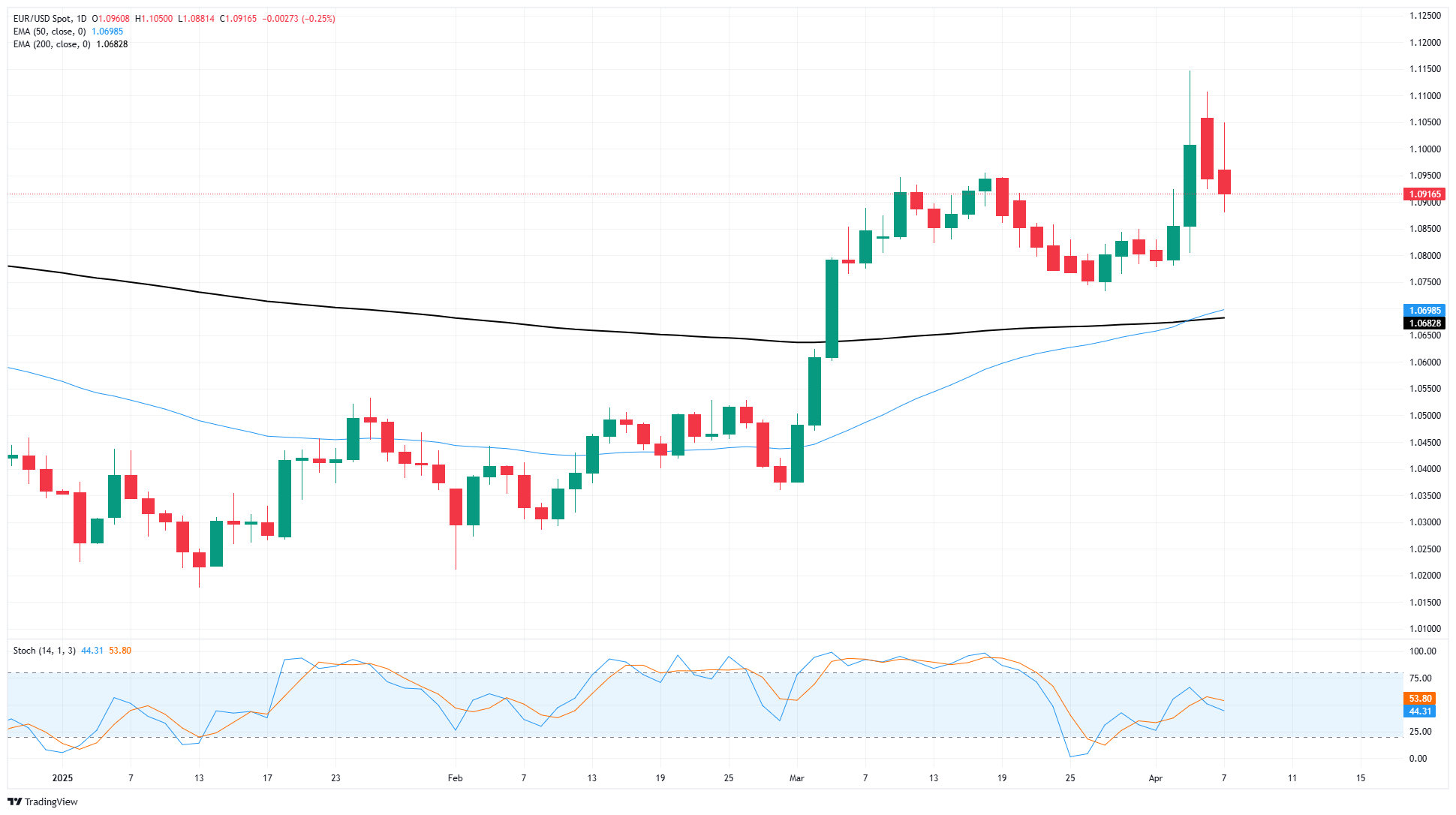EUR/USD continues to pare brief tariff gains
- EUR/USD has extended into a second day of declines as Greenback flows resume.
- US inflation and sentiment data to rule the economic calendar this week.
- Markets are betting on Fed rate cuts, but inflation risks remain tricky.
On Monday, EUR/USD dropped again, marking a second consecutive day of declines for Fiber and pushing bids down to the 1.0900 level. Following a short break, the US Dollar is back in control of risk-off flows, with weakening investor sentiment further strengthening the Greenback across the board.
Fresh tariff threats crimp risk appetite
Following a tense week during which the US fully embraced a protectionist trade policy- despite lacking the necessary industry infrastructure- import tariffs have been established. The US is now applying a blanket 10% import tax on all goods from every country, along with varying “reciprocal” tariffs calculated by dividing US imports by exports. After a 34% tariff was levied on Chinese products, China responded with its own 34% tariff on all goods imported from the US. Unable to find alternative solutions, the Trump administration has threatened to impose an additional 50% tariff on all Chinese goods, which is scheduled to take effect in April 8.
Forex Today: Trump’s tariffs remain in centre stage ahead of US CPI
This week, US data takes center stage again, with the Consumer Price Index (CPI) inflation figures set for release on Thursday. On Friday, we can expect the Producer Price Index (PPI) inflation numbers and the University of Michigan (UoM) Consumer Sentiment Index survey results. These will serve as the final key US inflation and sentiment indicators from the pre-tariff period of 2025, offering a vital measurement benchmark for the year's remaining months.
According to the CME’s FedWatch Tool, investors are increasing their bets that the Federal Reserve (Fed) will start cutting interest rates to mitigate recession risks. Markets are factoring in nearly 200 basis points of rate reductions through the rest of 2025, even as the Fed issues cautious policy statements indicating that trade uncertainty complicates any potential rate cuts rates.
EUR/USD price forecast
EUR/USD briefly surged into multi-month highs above 1.1100 after the US Dollar took a beating thanks to the US’s new tariff strategy. However, safe haven flows have resumed favoring the Greenback, sending Fiber down from new highs and retesting the 1.0900 handle with more losses on the cards.
EUR/USD daily chart

Euro FAQs
The Euro is the currency for the 19 European Union countries that belong to the Eurozone. It is the second most heavily traded currency in the world behind the US Dollar. In 2022, it accounted for 31% of all foreign exchange transactions, with an average daily turnover of over $2.2 trillion a day. EUR/USD is the most heavily traded currency pair in the world, accounting for an estimated 30% off all transactions, followed by EUR/JPY (4%), EUR/GBP (3%) and EUR/AUD (2%).
The European Central Bank (ECB) in Frankfurt, Germany, is the reserve bank for the Eurozone. The ECB sets interest rates and manages monetary policy. The ECB’s primary mandate is to maintain price stability, which means either controlling inflation or stimulating growth. Its primary tool is the raising or lowering of interest rates. Relatively high interest rates – or the expectation of higher rates – will usually benefit the Euro and vice versa. The ECB Governing Council makes monetary policy decisions at meetings held eight times a year. Decisions are made by heads of the Eurozone national banks and six permanent members, including the President of the ECB, Christine Lagarde.
Eurozone inflation data, measured by the Harmonized Index of Consumer Prices (HICP), is an important econometric for the Euro. If inflation rises more than expected, especially if above the ECB’s 2% target, it obliges the ECB to raise interest rates to bring it back under control. Relatively high interest rates compared to its counterparts will usually benefit the Euro, as it makes the region more attractive as a place for global investors to park their money.
Data releases gauge the health of the economy and can impact on the Euro. Indicators such as GDP, Manufacturing and Services PMIs, employment, and consumer sentiment surveys can all influence the direction of the single currency. A strong economy is good for the Euro. Not only does it attract more foreign investment but it may encourage the ECB to put up interest rates, which will directly strengthen the Euro. Otherwise, if economic data is weak, the Euro is likely to fall. Economic data for the four largest economies in the euro area (Germany, France, Italy and Spain) are especially significant, as they account for 75% of the Eurozone’s economy.
Another significant data release for the Euro is the Trade Balance. This indicator measures the difference between what a country earns from its exports and what it spends on imports over a given period. If a country produces highly sought after exports then its currency will gain in value purely from the extra demand created from foreign buyers seeking to purchase these goods. Therefore, a positive net Trade Balance strengthens a currency and vice versa for a negative balance.

